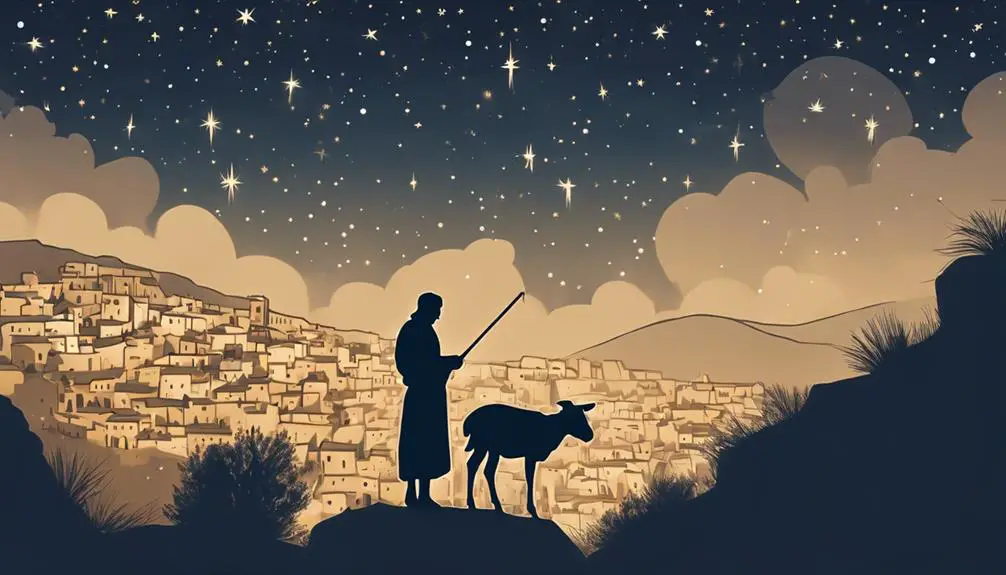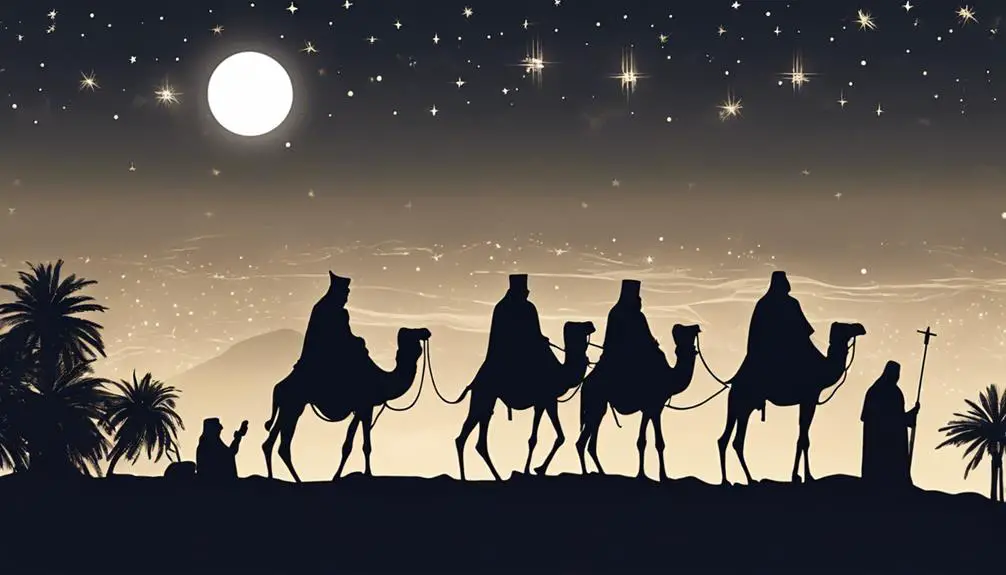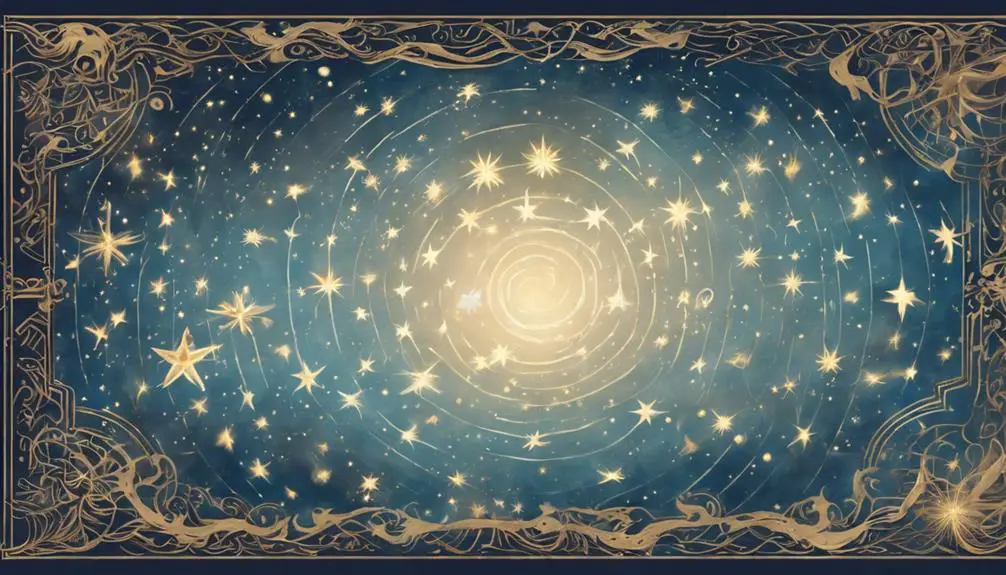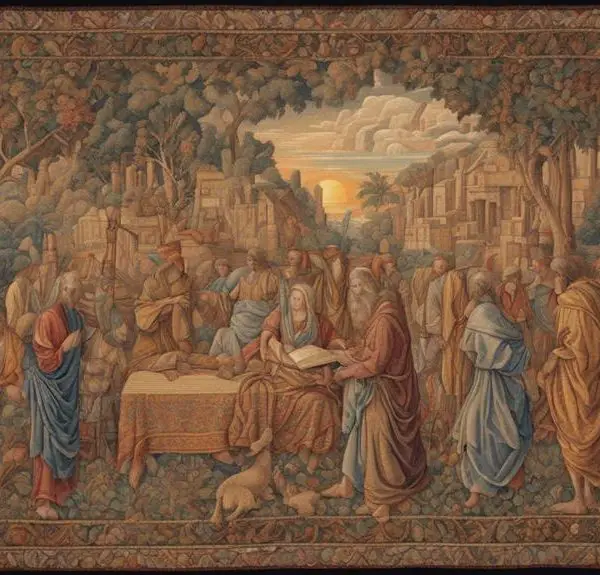Beyond celestial bodies, uncover the profound meanings of the 11 stars in biblical narratives and their impact on ancient and modern interpretations.

11 Stars in the Bible
Consider the story of Joseph, who dreamt of eleven stars bowing down to him, a vision that later mirrored his rise to power and the eventual bowing of his brothers. You're likely familiar with this narrative, but have you ever paused to ponder the broader significance of stars within biblical texts?
From creation to prophecy, stars play pivotal roles that weave through the fabric of biblical stories, offering insights into the culture, theology, and cosmology of ancient times. Unpacking these celestial symbols can illuminate intriguing aspects of faith and history that you might not have encountered before.
Key Takeaways
- Stars in the Bible symbolize divine order, sovereignty, and the omnipotence of the Creator.
- Biblical narratives use stars to signify God's promises of prosperity and multiplication to His chosen people.
- Stars play a role in divine communication, serving as symbols in prophecies and dreams within biblical stories.
- Astronomical events and constellations, like the Star of Bethlehem and Orion, carry deep symbolic meanings in biblical texts.
The Creation of Stars

In the Biblical account, God meticulously created the stars on the fourth day of creation, a detail that underscores their significance in the cosmic order. This act wasn't arbitrary; it was imbued with deep cosmic purpose and layered with starlight symbolism. You see, the stars were tasked with governing the night, marking seasons, days, and years, thus establishing a harmonious rhythm in the universe. Their creation was a deliberate act to illuminate the expanse of the heavens, serving not just as physical light sources but also as beacons of divine order.
Furthermore, the stars' formation carried profound symbolic weight. In ancient times, people often associated celestial bodies with the divine, viewing their unchanging nature as a reflection of the eternal. Thus, the stars in the Biblical narrative are more than mere physical entities; they're emblematic of God's unchanging nature and His sovereignty over creation. Their twinkling presence in the night sky served as a constant reminder of the Creator's omnipotence and the meticulous care with which He arranged the cosmos. This symbolism of starlight, therefore, extends beyond mere physical light to encompass a deeper, spiritual illumination, guiding humanity in the darkness.
Abraham's Descendants
Shifting focus from the celestial to the terrestrial, the narrative of Abraham's descendants unfolds as a pivotal moment in Biblical history, revealing the intricate link between the stars above and God's promises to humanity. The covenant made with Abraham by God serves as the cornerstone of this narrative, symbolizing a profound promise of prosperity and multiplication. This covenant isn't merely a verbal agreement but is rich in symbolic gestures and promises, deeply embedded in the culture and theology of the time.
The enumeration of Abraham's descendants, as numerous as the stars, serves as a tangible manifestation of God's promise. This imagery underscores three critical aspects:
- Covenant Symbolism: The stars as a symbol represent not only the vastness of Abraham's future progeny but also the unfathomable depth of God's commitment.
- Genealogical Promises: The promise extends beyond Abraham, signifying a perpetual blessing that threads through generations, marking the beginning of a chosen lineage.
- Divine Favor: This favor isn't arbitrary but is rooted in God's deliberate choice, highlighting a unique relationship with Abraham and his descendants.
In dissecting this narrative, one appreciates the complex interplay between divine promises and their earthly manifestations, showcasing the enduring nature of the covenant and its genealogical implications.
Joseph's Dream

Dreams serve as a profound vehicle for divine communication in the Biblical narrative, notably illustrated through Joseph's celestial visions that foreshadow his future sovereignty and the intricate dynamics within his family. Joseph's dreams, rich in symbolic imagery, aren't merely flights of fancy but a prelude to his eventual ascendancy and the complex interplay of family dynamics that would unfold as a result.
In one of Joseph's dreams, the sun, moon, and eleven stars bow to him, a vivid representation of his parents and brothers showing obeisance. This vision, while foretelling Joseph's rise to a position of significant power, also sets the stage for the tension and jealousy that would erupt among his brothers. It's essential to understand that dream interpretation in this context isn't a mere act of deciphering symbols but recognizing the manifestation of divine will through these nocturnal visions.
Joseph's ability to interpret dreams becomes his pathway to power, highlighting the importance of understanding and acting upon God's messages. However, it's the family dynamics, exacerbated by the envy his brothers harbor towards him, that catalyze the events leading to his eventual position of authority in Egypt. This story underscores the dual themes of divine communication and the complex web of family relationships, illustrating how both play pivotal roles in the unfolding of God's plans.
Balaam's Prophecy
Another significant instance of divine communication in the Bible is Balaam's prophecy, which unveils God's will through a narrative filled with intrigue and divine intervention. This story, found in the Book of Numbers, highlights the complex relationship between humans and the divine, showcasing how messages from God weren't only delivered through prophets but also through less conventional means, such as a prophet's donkey.
In analyzing Balaam's prophecy, consider the following points:
- Divine Communication: The story emphasizes God's sovereignty and the unexpected ways He communicates His will. It challenges the notion of who's deemed worthy of receiving divine messages, extending beyond prophets to include animals.
- Prophet's Donkey: The donkey plays a crucial role, acting as a medium for divine intervention. This element underscores the importance of humility and listening, as even the most unlikely sources can carry profound truths.
- Human-Divine Interaction: The narrative illustrates the dynamics between divine commands and human free will, showcasing the tensions and negotiations that often characterize this relationship.
Balaam's prophecy serves as a reminder of the multifaceted ways in which divine communication can manifest, urging readers to remain open to the unexpected and to recognize the presence of the divine in all aspects of life.
The Star of Bethlehem

As we delve into the significance of the Star of Bethlehem, it's crucial to understand its role as both a celestial and prophetic symbol in the biblical narrative. This star, guiding the Magi to Jesus' birthplace, intertwines astronomical theories with historical interpretations, offering a rich tapestry for scholarly analysis.
Astronomical theories propose various celestial events as the Star of Bethlehem, including comets, supernovae, and planetary conjunctions. Each theory attempts to pinpoint the star's scientific basis, suggesting that natural phenomena could explain this biblical marvel. Historically, these explanations have evolved, reflecting advancements in our astronomical knowledge and understanding of ancient texts.
Historical interpretations, on the other hand, delve into the symbolic significance of the star within the context of the biblical era. Scholars analyze ancient texts and archaeological findings to infer how contemporaneous audiences might've perceived such a phenomenon. This approach considers the star not just as a physical entity but as a potent symbol of divine intervention and fulfillment of prophecy.
In combining astronomical theories with historical interpretations, you gain a multifaceted understanding of the Star of Bethlehem. It's an exploration that bridges the gap between science and faith, illuminating the star's enduring mystery and significance in the biblical tradition.
The Morning Star
Often referred to in biblical texts, the Morning Star holds a complex and multifaceted role within Christian eschatology and symbolism, inviting a thorough scholarly examination. This celestial phenomenon, while captivating in its own right, has stirred significant debate, especially concerning Lucifer's identity and its astronomical symbolism.
- Lucifer's Identity: Traditionally, the term 'Morning Star' has been associated with Lucifer, a name that, prior to Christian tradition, denoted the planet Venus's appearance in the morning sky. The connection between Lucifer and the Morning Star stems from interpretations of passages like Isaiah 14:12, which in some translations, names Lucifer as the Morning Star fallen from heaven. This has led scholars to explore the metaphorical implications of light and darkness, and the transition from one state to another.
- Astronomical Symbolism: The Morning Star, as an astronomical body, symbolizes the heralding of dawn. In biblical context, this has been interpreted to represent knowledge, enlightenment, and the promise of a new beginning. Its appearance in the sky, distinct and bright, serves as a powerful metaphor for spiritual awakening and hope.
- Eschatological Significance: In Revelation 22:16, Jesus identifies Himself as the 'bright Morning Star,' which introduces a layer of redemption to the symbol. This identification links the Morning Star with divine guidance, the victory of light over darkness, and the ultimate triumph of good over evil.
The Seven Stars

In biblical scholarship, the reference to the Seven Stars signifies a profound symbol woven into the fabric of apocalyptic literature, notably within the Book of Revelation. This imagery isn't merely decorative; it's laden with meanings that you can decipher, offering insights into the ancient world's relationship with the cosmos. Star symbolism in this context goes beyond the mere admiration of celestial beauty; it embodies the idea of guidance, both spiritually and physically through celestial navigation.
The Seven Stars, as mentioned in Revelation, are often interpreted to represent the seven churches. However, the symbolism extends further, touching on the perfection and completeness often associated with the number seven in biblical texts. This inclusion underscores the stars' role as divine navigators, not just in the physical sense of guiding travelers or marking seasons, but in offering spiritual direction to the faithful.
You'll notice that the use of celestial imagery in the Bible isn't arbitrary. It's a deliberate choice that reflects the ancient understanding of the cosmos as a map, both for the soul's journey towards enlightenment and for navigating the physical world. The Seven Stars, thus, serve as a bridge between heaven and earth, guiding humanity through both its spiritual and temporal voyages.
Orion and Pleiades
Building on the theme of celestial guidance, the Bible also references Orion and Pleiades, constellations that further elucidate the text's rich astronomical tapestry. These star clusters aren't merely decorative; they carry profound symbolic weight and are integral to understanding the biblical worldview.
Orion, known for its distinctive belt, is more than a striking figure in the night sky; it's imbued with rich mythological narratives. Orion's myth, with its themes of pursuit and transformation, mirrors the dynamic and often tumultuous relationship between humanity and the divine. This constellation serves as a reminder of the power and mystery that pervade the universe, urging you to reflect on your place within it.
Pleiades, on the other hand, holds a different kind of significance. This compact cluster of stars, visible even to the naked eye, has been interpreted as a symbol of unity and brotherhood. Its appearance in the scriptures underscores the importance of community and the interconnectedness of all creation.
Consider these points:
- Orion's myth offers a narrative-rich backdrop to biblical references, inviting deeper contemplation of the text.
- Pleiades' significance as a symbol of unity enriches the biblical call for communal harmony.
- Both constellations highlight the Bible's engagement with the cosmos, illustrating the intricate relationship between the divine, humanity, and the universe.
The Host of Heaven

The term 'Host of Heaven' refers to a celestial assembly that plays a pivotal role in biblical narratives, serving as both witnesses and participants in the divine plan. This concept is deeply rooted in ancient cosmology, where the stars weren't just celestial bodies but entities with divine significance. You'll find that celestial worship, a practice condemned in the Bible, often revolved around this host, indicating their revered status among ancient peoples.
In the scriptures, star naming emerges as a motif that underscores the intimate knowledge and sovereignty of God over the cosmos. Each star, part of the 'Host of Heaven,' isn't just a speck of light but a named entity in a divine registry. This act of naming by God is significant, as it denotes not only creation but also ownership and authority over the celestial realm.
Analyzing these references, you come to understand the 'Host of Heaven' as a multifaceted concept. It's a symbol of the vastness and order of the cosmos, a testament to divine power, and a reminder of the fine line between reverence and idolatry in celestial worship. The interplay between these elements within biblical texts provides a rich tapestry of meaning and insight into the ancient worldview.
Stars in Revelations
How does the Book of Revelation transform our understanding of stars from mere celestial bodies to symbols laden with prophetic significance? In this dense, final book of the New Testament, stars are reimagined through a lens of apocalyptic imagery and dragon symbolism, elevating them beyond their astronomical roles to embody deeper, eschatological meanings.
- Dragon Symbolism: Revelation 12 describes a great red dragon, its tail sweeping a third of the stars out of the sky and hurling them to Earth. This vivid imagery isn't just about celestial mechanics; it's an allegory of cosmic struggle, with stars serving as pawns in a celestial battle between good and evil.
- Apocalyptic Imagery: Stars in Revelation are components of the apocalyptic scenery, each bearing a message of impending judgment and the collapse of earthly kingdoms. They aren't just lights in the sky but harbingers of doom, signaling the end times.
- Prophetic Significance: Beyond their symbolic role in the narrative, stars in Revelation are imbued with prophetic significance, forecasting events and serving as signs of divine intervention in human affairs. This transformation underscores the stars' role in the divine plan, far removed from their scientific explanations.
The Bright and Morning Star

Examining the Book of Revelation further, we encounter 'The Bright and Morning Star' as a pivotal symbol, offering profound insights into the nature of Christ and his promise to believers. This metaphor, rich in celestial symbolism, underscores Christ's role as the ultimate source of light and guidance, mirroring the morning brightness that heralds the dawn. It's an evocative image, positioning Christ not only as a beacon in the spiritual darkness but also as a harbinger of a new era.
Delving deeper, we find that the 'Morning Star' stands apart in its unique representation of hope and renewal. Just as the morning star signals the end of night and the beginning of a new day, Christ's designation as 'The Bright and Morning Star' symbolizes the promise of salvation and the dawning of spiritual enlightenment. This celestial symbolism is meticulously chosen to reflect the transformative power of Christ's presence in the lives of believers, illuminating the path towards redemption with the morning brightness of his teachings.
In essence, 'The Bright and Morning Star' serves as a profound metaphor within the biblical narrative, encapsulating the essence of Christ's mission and the eternal promise of spiritual renewal.
Frequently Asked Questions
How Have Interpretations of Stars in the Bible Evolved Over Time Due to Advancements in Astronomy and Cosmology?
As you delve into how interpretations of stars have evolved, it's crucial to consider the impact of advancements in astronomy and cosmology.
Scientific reinterpretation has played a key role, reshaping our understanding dramatically. This shift isn't just scientific; it's a cultural evolution, reflecting how societies adapt their worldviews in light of new knowledge.
Analyzing these changes offers detailed insights into the dynamic relationship between science, culture, and our conception of the universe.
In What Ways Have Biblical References to Stars Influenced Modern Cultural Expressions, Such as Literature, Art, and Music?
When you dive into how star names have been reinterpreted in modern times, it's fascinating to see their impact on literature, art, and music.
Take, for instance, how the Pleiades influence poetry, symbolizing beauty and mystery.
This reinterpretation digs deep into cultural festival origins, shedding light on how ancient celestial observations shape today's celebrations.
The transformation of these star references in cultural expressions showcases a rich blend of history, astronomy, and creativity.
Are There Any Biblical Stars or Constellations That Have Been Lost or Misidentified in Modern Translations of the Bible?
You're delving into how translation challenges may lead to the misidentification or loss of stars and constellations in modern Bible translations. This exploration uncovers the intricate balance between linguistic precision and cultural significance.
As translations evolve, the original astronomical references can become obscured, shedding light on the importance of historical and cultural context in preserving the richness of these ancient texts.
Analyzing these discrepancies offers insights into the transformative power of language and culture over time.
How Do Different Religious Traditions Interpret the Symbolism of Stars in the Bible Outside of the Christian Perspective?
You're exploring how stars capture imaginations across faiths, each tradition painting its celestial canvas.
In Islam, star symbolism often guides spiritual understanding, while Jewish astrological views might weave stars into narratives of destiny and divine messages.
Analyzing these perspectives, you'll find a rich tapestry of beliefs, where stars serve as more than mere points of light; they're symbols of guidance, wisdom, and the divine, intricately interpreted across religious traditions.
What Role Do Stars Play in Biblical Prophecies Not Directly Associated With the Ones Mentioned, Such as Those Found in the Books of Daniel or Ezekiel?
You're diving into how star symbolism and astrological interpretations play out in less commonly discussed biblical prophecies, like those in Daniel or Ezekiel. These texts use stars to signify divine plans or judgments, blending celestial imagery with prophetic messages.
They don't just decorate the sky; they're coded with meanings, forecasting events or symbolizing spiritual entities. Analyzing these passages reveals a rich tapestry of meaning, where stars aren't mere lights but bearers of God's will.
Conclusion
In your journey through biblical cosmology, you've traversed from the celestial blueprint of creation to prophetic symbols of hope and navigation.
Like ancient mariners guided by the night sky, you've gleaned insights from Abraham's countless descendants to the guiding light of the Star of Bethlehem.
The constellations of Orion and Pleiades, alongside the eschatological visions in Revelations, mirror humanity's enduring quest for divine orientation.
Reflecting on the 'Bright and Morning Star,' you stand at the nexus of faith and cosmos, where celestial narratives illuminate the human condition, urging a deeper contemplation of our place within this vast, star-studded tapestry.



Sign up